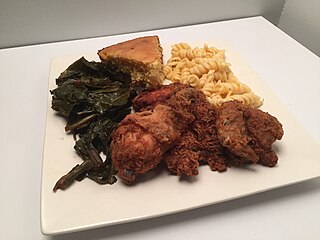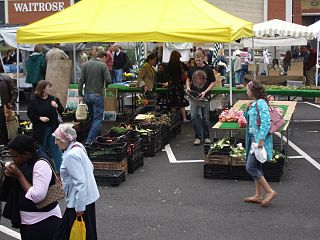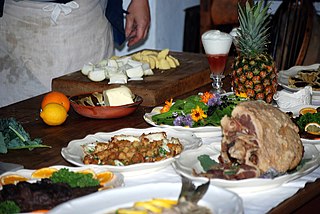
Cooking, also known as cookery or professionally as the culinary arts, is the art, science and craft of using heat to make food more palatable, digestible, nutritious, or safe. Cooking techniques and ingredients vary widely, from grilling food over an open fire, to using electric stoves, to baking in various types of ovens, reflecting local conditions. Cooking is an aspect of all human societies and a cultural universal.

Soul food is the ethnic cuisine of African Americans. Originating in the American South from the cuisines of enslaved Africans transported from Africa through the Atlantic slave trade, soul food is closely associated with the cuisine of the Southern United States. The expression "soul food" originated in the mid-1960s when "soul" was a common word used to describe African-American culture. Soul food uses cooking techniques and ingredients from West African, Central African, Western European, and Indigenous cuisine of the Americas.

Local food is food that is produced within a short distance of where it is consumed, often accompanied by a social structure and supply chain different from the large-scale supermarket system.

Raw foodism, also known as rawism or a raw food diet, is the dietary practice of eating only or mostly food that is uncooked and unprocessed. Depending on the philosophy, or type of lifestyle and results desired, raw food diets may include a selection of fruits, vegetables, nuts, seeds, eggs, fish, meat, and dairy products. The diet may also include simply processed foods, such as various types of sprouted seeds, cheese, and fermented foods such as yogurts, kefir, kombucha, or sauerkraut, but generally not foods that have been pasteurized, homogenized, or produced with the use of synthetic pesticides, fertilizers, solvents, and food additives.

Food miles is the distance food is transported from the time of its making until it reaches the consumer. Food miles are one factor used when testing the environmental impact of food, such as the carbon footprint of the food.

The cuisine of Botswana is unique but shares some characteristics with other cuisines of Southern Africa. Examples of Setswana food include pap, samp, magwinya, bogobe and mophane worms. A food unique to Botswana is seswaa, salted mashed-up meat.
Équiterre is a Canadian non-profit and non-governmental organization, operating in Quebec. It manages a community-supported agriculture system of farms and consumers, including households and institutions.

The 100-Mile Diet: A Year of Local Eating is a non-fiction book written by Canadian writers Alisa Smith and J.B. MacKinnon. In the book, the authors recount their experiences, including motivations and challenges, on restricting their diet, for one year, to include only foods grown within 100 miles of their residence. Beginning in March 2005, with little preparation the urban couple began only purchasing foods with ingredients they knew were all from within 100 miles. Finding little in grocery stores, they relied on farmers' markets and visits to local farms. Staples in their diet included seafood, chicken, root vegetable, berries, and corn. They lacked cooking oils, rice, and sugar. They preserved foods for use in the winter but ended with extra supplies.

The Hairy Bikers were a pair of English celebrity chefs comprising David Myers and Si King, whose television programmes combined cooking with motorcycling travelogue. Between 2004 and 2024, they hosted over 30 television series and specials for BBC One, BBC Two, Channel 5, and Good Food; they also wrote a number of tie-in cookbooks.
Jessica Prentice is a chef, author, and founding member of Three Stone Hearth, a community-supported kitchen in Berkeley, California. She is known for coining the word locavore, which is a movement in which people seek to eat locally grown foods, often defined as those available within a 100-mile radius.

The cuisine of the Thirteen Colonies includes the foods, bread, eating habits, and cooking methods of the Colonial United States.
Sociology of food is the study of food as it relates to the history, progression, and future development of society. This includes production, distribution, conflict, medical application, ritual, spiritual, and cultural applications, environmental and labor issues.
James Bernard MacKinnon, commonly cited as J.B. MacKinnon, is a Canadian journalist, contributing editor and book author. MacKinnon is best known for co-authoring with Alisa Smith the bestselling book The 100-Mile Diet: A Year of Local Eating, encouraging readers to focus on local eating as a way to address current environmental and economic issues. MacKinnon and Smith also collaborated in the creation of the Food Network Canada television series The 100 Mile Challenge, based on the book. He has won six National Magazine Awards, and the 2006 Charles Taylor Prize for best work of Literary Non-Fiction.

The White House has had multiple vegetable gardens since its completion in 1800. John and Abigail Adams, Eleanor Roosevelt, Hillary Clinton and Michelle Obama all have had their own versions of vegetable gardens. Roosevelt planted the White House victory garden during World War II to promote the use of victory gardens by American citizens in a time of possible food scarcity. Hillary Clinton had a vegetable garden constructed on the roof of the White House. On March 20, 2009, Michelle Obama broke ground on the largest and most expansive vegetable garden to date on the White House lawn.
A foodshed is the geographic region that produces the food for a particular population. The term is used to describe a region of food flows, from the area where it is produced, to the place where it is consumed, including: the land it grows on, the route it travels, the markets it passes through, and the tables it ends up on. "Foodshed" is described as a "socio-geographic space: human activity embedded in the natural integument of a particular place." A foodshed is analogous to a watershed in that foodsheds outline the flow of food feeding a particular population, whereas watersheds outline the flow of water draining to a particular location. Through drawing from the conceptual ideas of the watershed, foodsheds are perceived as hybrid social and natural constructs.

The cuisine of the antebellum United States characterizes American eating and cooking habits from about 1776 to 1861. During this period different regions of the United States adapted to their surroundings and cultural backgrounds to create specific regional cuisines, modernization of technology led to changes in food consumption, and evolution of taverns into hotels led to the beginnings of an American temperance movement. By the beginning of the Civil War, the United States cuisine and food culture could define itself separately from that of the rest of the world.

The cuisines of Oceania include those found on Australia, New Zealand, and New Guinea, and also cuisines from many other islands or island groups throughout Oceania.

Carrot soup is a soup prepared with carrot as a primary ingredient. It can be prepared as a cream- or broth-style soup. Additional vegetables, root vegetables and various other ingredients can be used in its preparation. It may be served hot or cold, and several recipes exist.
Ch'ang Ming is a series of dietary and health recommendations based on Taoist philosophy. It was first introduced to the West by Chan Kam Lee, a Taoist teacher and Chinese herbal medicine practitioner who came to London in 1930 from Shandong Province in China. He took the Taoist principles of Traditional Chinese Medicine and adapted them to Western foods and eating habits.

The cuisine of Papua New Guinea are the traditional varied foods found in the eastern part of the New Guinea island. Approximately 80% of the population is reliant on subsistence agriculture, so a large percentage of food energy and protein consumed in Papua New Guinea is produced locally, while the balance is imported. The staple foods in Papua New Guinea includes root crops, bananas, and sago. Papua New Guinea's diet is largely vegetarian, especially in the Gulf and Highlands regions.














